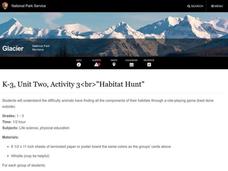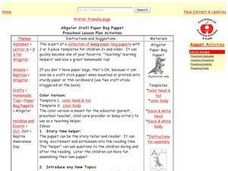Curated OER
Hoppy's Busy Day
In this reading comprehension worksheet, students read an Easter story titled Hoppy's Busy Day.Students then answer 4 reading comprehension questions.
Curated OER
Create a Research Book
Students use the internet to research the production of manuscripts and books. Using this information, they create a research book full of tips to research effectively. They share their new book with the class after organizing the material.
Curated OER
GIS: Mapping Watersheds of the Edwards Aquifer in Travis County
Students manipulate existing GIS data to create and map a new layer of information that shows that watersheds in Travis County that are on top of Edwards Aquifer. They create and map that shows the watersheds in Travis County that are on...
Curated OER
Your Own El Nino
Young scholars conduct an experiment. In this El Nino lesson, students learn where El Nino storms come from, what they consist of and what effects they have. Young scholars also complete an experiment where they create a...
Cornell University
Nano What?
The size of a nanoparticle is difficult for pupils to grasp. A hands-on experiment is designed to give your classes perspective. Learners analyze different sports drinks for the content of electrolytes as an introduction to nanoscale....
Curated OER
Let's Make Play Dough
Students create their own play dough to use for art projects. In this art activity, students measure, pour and mix the ingredients to make their own play dough. Then, students use the clay to create their own sculptures.
Curated OER
Floating and Falling Flows
Students discover fluid dynamics related to buoyancy through experimentation and optional photography. Using one set of fluids, they make light fluids rise through denser fluids. Using another set, they make dense fluids sink through a...
Curated OER
Where Growth Meets Growth
Students discuss fire risk factors for a property located near a wildland area. In this science lesson, students identify, number, and provide reasons for areas of increased risk on a worksheet they think should be changed. Students...
Curated OER
Shaving Cream Art
Students participate in paper marbling. In this paper art lesson plan, students use shaving cream and paint to create unique patterns on paper. Students mix shaving cream and paint together then lay paper down in the mix. The...
Curated OER
Planting Parts
Each student plants two lima beans in a plastic cup with a paper towel so they can be observed growing. The beans are misted with a spray bottle, and placed in a warm sunny area. Students view the beans each day for the next two weeks,...
Curated OER
What is Gyotaku
Third graders make a T-shirt. In this fish printing lesson, 3rd graders learn about Gyotaku and the history of fish printing. The teacher demonstrates how to do a fish printing for a T-shirt and then students make their own T-shirts and...
Curated OER
Shaker Band
Students shake up some lively music. In this early childhood music and art lesson, students use a variety of materials to make shakers that will acquaint them with different rhythms and enhance their sensory awareness.
Curated OER
Garden of Eden
Students view a video clip about animals and their habitats. They work together to discuss how different animals adapt to their environments. They create a new habitat for a specific animal and draw new adaptations for them.
Curated OER
Crash of Flight 111
Students identify the locations on a map of the airplane crashes discussed in this lesson. After watching a video, they discuss the importance of an investigation after a plane crash. They use the same information as the investigators...
Curated OER
Make it a habitat
Students consider the adaptation of life forms through natural selection to fill various niches and accommodate changing environmental conditions. They select an ecosystem and conduct research to provide as much detailed information as...
Curated OER
Black Death Biology
Students in pairs explore the transmission of the Plague, through experimentation. Cooperative groups use the scientific method to solve the fictional problem of a bacteria spreading in the Amazon. Groups also create a vector to visually...
Curated OER
Hatching Chickens
Young scholars learn the importance of caring for eggs as they hatch chickens. In this egg hatching lesson, students observe what happens when eggs are hatched into chickens by completing a e-worksheet and watching a web based movie.
Curated OER
Habitat Hunt
Students discover how hard it is for animals to find all the items needed in their habitat. In this habitat lesson, students play a game in which they pretend to be an animal, they discover that not all animals can find the food needed...
Curated OER
A Model of Earth's Tectonic Plates
Students build a model of the Earth showing tectonic plate boundaries. The pattern for the model is provided in the lesson. This is a very useful hands-on component for a lesson about geology or earthquakes.
Curated OER
Time and Cycles - Dendrochronology
Middle schoolers investigate the lives of trees by examining ring cycles. In this plant life instructional activity, students identify the field of study known as dendrochronology and discover its history. Middle schoolers...
Curated OER
Alligator Craft Paper Bag Puppet
Students make paper bag puppets. They use the puppets as a story teller and reader. Students use the puppets to ask questions during and after reading. They assemble their own puppet. Students use the puppets to introduce new themes,...
Curated OER
Wax Resist Fish
Students review what a pattern is and they create a pattern on a fish. They are reminded that patterns do not change halfway through and they paint over it with watercolor paints. They display their fish on the walls.
Curated OER
Watercolor Rainbow Fish
Students experience an art project as a follow up to reading The Rainbow Fish.
Curated OER
Progressive City Planners
Students plan cities. In this environmental racism activity, students design imaginary cities taking into consideration the amenities and environmental hazards that exist. Students discuss city planning challenges.

























